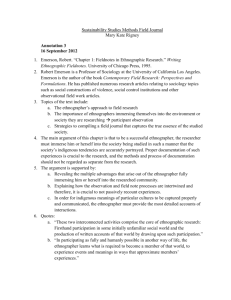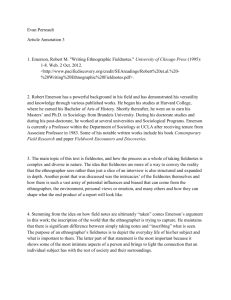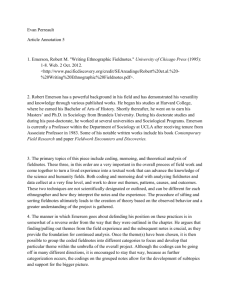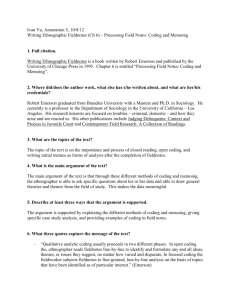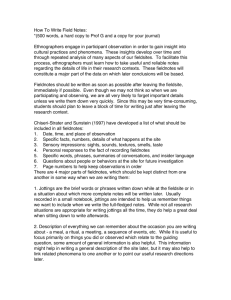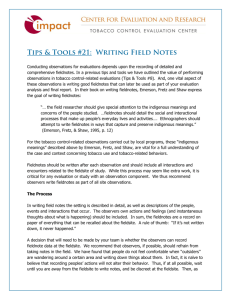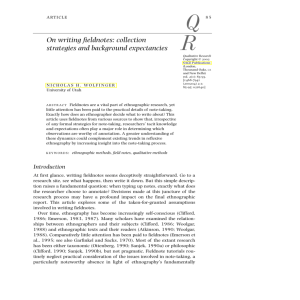annotation 6 - STSSustainabilityStudiesMethods
advertisement
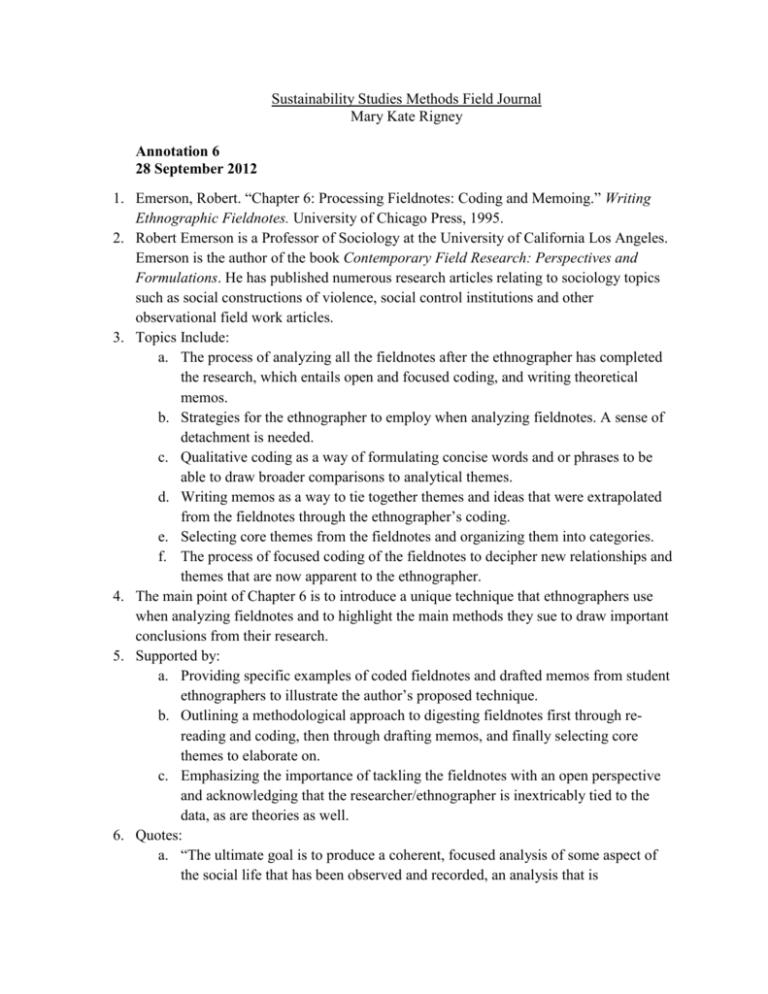
Sustainability Studies Methods Field Journal Mary Kate Rigney Annotation 6 28 September 2012 1. Emerson, Robert. “Chapter 6: Processing Fieldnotes: Coding and Memoing.” Writing Ethnographic Fieldnotes. University of Chicago Press, 1995. 2. Robert Emerson is a Professor of Sociology at the University of California Los Angeles. Emerson is the author of the book Contemporary Field Research: Perspectives and Formulations. He has published numerous research articles relating to sociology topics such as social constructions of violence, social control institutions and other observational field work articles. 3. Topics Include: a. The process of analyzing all the fieldnotes after the ethnographer has completed the research, which entails open and focused coding, and writing theoretical memos. b. Strategies for the ethnographer to employ when analyzing fieldnotes. A sense of detachment is needed. c. Qualitative coding as a way of formulating concise words and or phrases to be able to draw broader comparisons to analytical themes. d. Writing memos as a way to tie together themes and ideas that were extrapolated from the fieldnotes through the ethnographer’s coding. e. Selecting core themes from the fieldnotes and organizing them into categories. f. The process of focused coding of the fieldnotes to decipher new relationships and themes that are now apparent to the ethnographer. 4. The main point of Chapter 6 is to introduce a unique technique that ethnographers use when analyzing fieldnotes and to highlight the main methods they sue to draw important conclusions from their research. 5. Supported by: a. Providing specific examples of coded fieldnotes and drafted memos from student ethnographers to illustrate the author’s proposed technique. b. Outlining a methodological approach to digesting fieldnotes first through rereading and coding, then through drafting memos, and finally selecting core themes to elaborate on. c. Emphasizing the importance of tackling the fieldnotes with an open perspective and acknowledging that the researcher/ethnographer is inextricably tied to the data, as are theories as well. 6. Quotes: a. “The ultimate goal is to produce a coherent, focused analysis of some aspect of the social life that has been observed and recorded, an analysis that is comprehensible to readers who are not directly acquainted with the social world at issue.” b. “In creating codes, the fieldworker is engaged in an analytic process; she seeks to move beyond the particular event or situation in the fieldnotes to capture some more general theoretical dimension or issue.” c. “In sum, initial coding and memoing require the ethnographer to step back from the field setting to identify, develop, and modify broader analytic themes and arguments. Early on, these efforts should remain flexible and open, as the ethnographer reads, codes and analyzes fieldnotes to foster a wide range of new ideas, linkages, and connections.” 7. Questions: a. What aspect of analyzing fieldnotes—coding, writing memos and identifying themes—should the ethnographer focus the most time on? b. Are certain organizational techniques beneficial to particular types of fieldnotes, i.e. would it be advantageous to organize fieldnotes dealing with water access in a particular manner compared to fieldnotes dealing with the role of women in a particular culture? c. Would dividing up the fieldnotes and covering them in sections first be advised against? 8. Further Research a. More examples of common coding techniques employed by ethnographers. b. Research whether there are generic themes that arise out of ethnographic fieldwork. c. Look into whether there are any exercises that can help the student ethnographer prepare for a task such as coding, memoing and drawing out themes.
